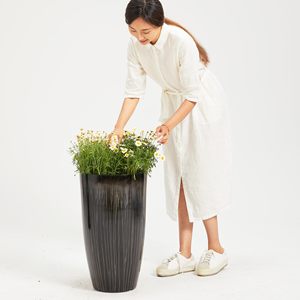
All categories
Featured selections
Trade Assurance
Buyer Central
Help Center
Get the app
Become a supplier

(4739 products available)



















































The garden pots for plants are made from recycled plastic materials. These types of plant pots are eco-friendly options for homeowners and commercial businesses. There are several different types of recycled plastic plant pots are available:
PP (Polypropylene) Plant Pots:
PP plant pots are made from a durable and flexible plastic. This material is known for its ability to withstand repeated use. It is also resistant to chemicals and does not easily break when dropped. Because of its toughness, PP is commonly used for larger planters and pots that are used in commercial nurseries. These plant pots can be recycled when they are no longer needed.
PE (Polyethylene) Plant Pots:
PE plant pots are created with a lightweight and moisture-resistant material. This type of plastic is suitable for holding water without leaking. It can be easily stretched and compressed but does not shatter when it hits a hard surface. Its flexibility makes it ideal for smaller containers, hanging baskets and larger planters. Like PP pots, these containers can also be recycled.
RPET (Recycled PET) Plant Pots:
RPET plant pots are produced using post-consumer recycled PET bottles. This material is suitable for making products with a lower impact on the environment. These bottles are turned into a usable plastic pot. The process helps to reduce the amount of plastic waste in landfills. RPET pots are clear and rigid. They are commonly used in retail settings where the plants are on display. They can be recycled at the end of their use.
PLA (Polylactic Acid) Plant Pots:
PLA plant pots are made using a biodegradable plastic. This material is created from renewable resources like corn starch. It is suitable for products that are composted rather than recycled. This type of pot can break down in a composting facility. It is a good option for businesses that want to reduce their carbon footprint. PLA is not derived from petroleum-based materials. So, it helps to lower the use of fossil fuels.
Sustainability:
Recycled plastic plant pots are sustainable products. They are usually made from post-consumer plastics such as PET bottles and food containers. They can be produced using HDPE plastic, which has a high recycling rate. These plant pots can also be recycled, making them an eco-friendly option for gardening and landscaping.
Durability:
These flower pots are more durable than many traditionally used clay pots. They are resistant to shock, moisture, and most chemicals. Using these plant pots reduces the risk of breakage and injury and lowers the chances of overwatering the plants.
Lightweight:
These plant pots are lightweight. Using these plant pots in gardening and landscaping makes them easier to move, reducing the overall project weight and labor cost.
UV Resistant:
Most recycled plastic plant pots are UV-resistant. Therefore, they do not easily degrade when exposed to sunlight. This feature extends the lifespan of these plant pots when used outdoors.
Waterproof:
These plant pots are waterproof. Therefore, they do not absorb water and reduce the risk of mold growth. Using these plant pots improves the overall health of the plants.
Insulation from Temperature:
These plant pots can insulate plants from fluctuations in ambient temperature. The insulation they provide can help to maintain consistent soil temperature, improving plant growth and health.
Customization and Aesthetics:
These plant pots are available in many colors, shapes, and sizes. They can be customized to meet the needs of the customer. Using these plant pots does not compromise the aesthetic appeal of gardens or landscapes.
Reduced Root Circling:
These plant pots are designed to reduce root circling. They promote healthy root growth and reduce the risk of transplant shock.
Ease of Use:
Planting and transplanting are easier with recycled plastic plant pots. They also often come with features such as handles, making them easier to work with.
Cost-Effective:
Although the initial cost of recycled plastic plant pots may be higher than traditional clay pots, they are more durable and can be reused for longer. Their long-term cost is usually lower, making them a cost-effective option.
Urban Gardening
The urban garden is small yet mighty. It supplies fresh veggies, fruits, and herbs to city dwellers with limited space. The garden uses recycled plastic plant pots to maximize space. The vertical garden style allows for more growing in apartments, balconies, or rooftops. The urban garden shows that even small spaces can produce big food. With careful planting in pots, city folks can enjoy homegrown produce.
Hydroponic Systems
Hydroponics is soilless gardening that grows plants in nutrient-rich water. Recycled plastic plant pots work well for hydroponic systems. The pots hold plants above water, letting roots reach down to the liquid nutrients. Using pots in hydroponics makes it easy to move plants around. This increases efficiency by rearranging crops for best growth. Pots also keep different plants separate, which helps control diseases. Hydroponic systems with plastic pots can produce food faster than soil gardens. This method conserves water too. Hydroponics with recycled pots shows a sustainable way to grow in tight spaces.
Vertical Gardens
Vertical gardens use walls instead of floors to hold plants. They save room in places where garden space is limited. Vertical gardens made with recycled plastic plant pots are another option for urban areas. The pots hang on frames or grids built into walls. Plants in these vertical pots thrive indoors or outdoors. Users can grow greens, flowers, or herbs this way without big yard footprints. Vertical gardens also clean the air and cool buildings. They provide food and trim energy bills. Gardens built up instead of out show another side of urban greening.
Seasonal Planting
Seasonal planting means changing what is grown based on the time of year. This works well with plants in recycled plastic pots. When the weather shifts, the whole garden can too. Moving pots makes it easy to swap out crops for seasonal varieties. This flexibility lets gardeners keep production high year-round. It also reduces pressure on soil since plants don't stay in one place long. Seasonal pot planting fits well in places where conditions vary a lot. Greenhouses and patios benefit from the quick changes possible with portable containers. Using pots for seasonal rotations shows another advantage of container gardening.
From a sustainability viewpoint, choosing the right plant pots is very important. The following factors should be considered when selecting these containers.
Sustainability of Recycled Material
Go for pots made from post-consumer recycled content, such as HDPE. These are materials sourced from ordinary people's plastic waste. Also, choose pots made from bio-based plastics. These are plant-based materials, like sugars and starches, created from renewable sources. They have a lower environmental impact than oil-based plastics.
Durability and Longevity
Opt for durable pots that can withstand long-term use. Durable recycled plant pots reduce the need to create new ones frequently. They also minimize waste. Look for pots that are UV-resistant, impact-resistant, and able to hold water without cracking or breaking.
Ease of Reuse and Recycling
Choose pots that are easy to clean and reuse for other purposes. Also, select those that can be recycled at the end of their life. This helps keep them out of landfills. To ensure proper recycling, find out what local recycling programs accept. Then, check the recycling symbols on the bottom of your pots. They show what plastic type was used. Also, choose plant pots made from materials like PP and HDPE. These are usually recycled in many communities. Avoid materials like polystyrene foam. It's often not accepted by recycling centers.
Environmental Impact of Manufacturing Process
Consider the energy and water used to make the plant pots. Choose those with low resources and minimal greenhouse gas emissions. Ask suppliers about their production methods. Then, look for pots made with less energy. Find out if renewable energy was used. Also, check for water-saving techniques and waste reduction measures.
Q1: Are recycled plastic plant pots good for plants?
A1: Recycled plastic plant pots are safe for plants. They pass strict tests on materials that contact food and drinks. These standards check if the pot material could harm plants.
Q2: How long do recycled plastic plant pots last?
A2: Recycled plastic plant pots are durable. They can last for years. The exact time depends on the pot use and the plastic type. Most recycled plastics have a long lifespan.
Q3: Do recycled plastic plant pots smell?
A3: New plant pots may have a slight plastic smell. The scent is usually weak and goes away quickly. If the smell lingers, it could be from the materials used. It is best to move the pot and plant outside until the smell fades.
Q4: Can plant pots with holes in the bottom be placed in the ground?
A4: It is acceptable to bury pots with drain holes. The holes allow water to drain. They also let the soil mix. Ensure the pot material is suitable for the plant. Some plastics can add toxins to the soil over time.
Q5: Can plant pots be recycled?
A5: Most local recycling programs accept plant pots. Recycle the hard plastic pots. Do not recycle soft or crushable pots. They are usually not recyclable. Check the recycling symbols on the bottom of the pots to know which type they are.